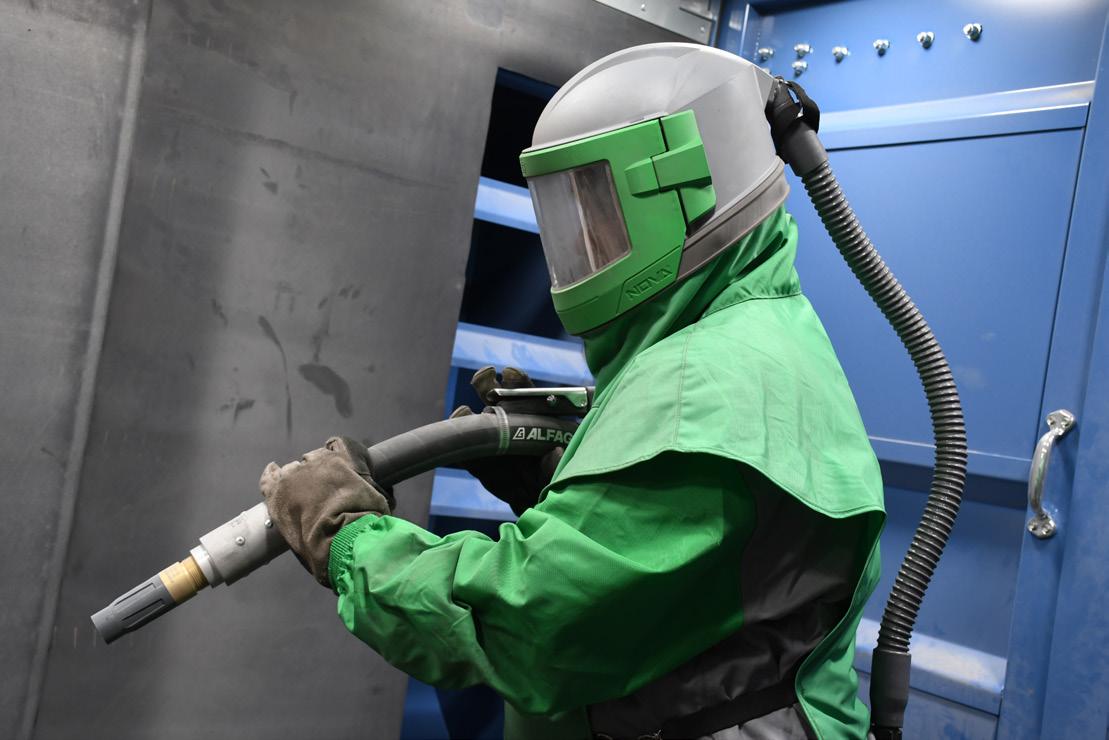
4 minute read
MISSION CRITICAL: NNSY'S
Martin Trzcinski, Code 970, Preservation Mechanic, outfitted in the required personal protective equipment (PPE) to operate the Critical Coat Blast Booth in Shop 71. Code 970, Shop 71 employees Daniel Gurganus, Preservation Supervisor; Mark Kaufman, Preservation Work Lead Mechanic; Martin Trzcinski, Preservation Mechanic; and Tracy Robinson, Inside Shops Preservation Zone Manager, in front of the new Critical Coat Blast Booth. The booth provides energy and time savings, while reducing material costs.

Advertisement
MISSION CRITICAL:
NNSY’S NEW CRITICAL COAT BLAST BOOTH
STORY AND PHOTOS BY JASON SCARBOROUGH • PUBLIC AFFAIRS SPECIALIST
Norfolk Naval Shipyard’s (NNSY) Paint and Blasting Shop (Code 970, Shop 71) is helping to bridge the gap between the shipyard’s mission and its vision.
Shop 71’s recent equipment upgrade of a Critical Coat Blast Booth improved improve NNSY’s infrastructure, one of the four focus areas, or pillars, of the Strategic Framework. With this equipment upgrade, Shop 71 has improve energy savings, material costs, and will require less working hours to complete painting and blasting.
A Critical Coat Blast Booth is a fully enclosed abrasive blasting booth that is environmentally controlled by the use of heating, ventilation and air conditioning equipment used to meet surface preparation requirements. This is done by using media to physically blast different metals such as steel or aluminum surfaces. The booth also has a single point, touch screen control center capable of reporting the current temperature and humidity and assisting troubleshooting support in the event of a failure.
The system is designed to use aluminum oxide blast media, but it is capable of other types of media due to its rugged design. Blasted grit light enough to be lifted through the air is filtered out by a high efficiency bag-filter house. Energy is saved by not having to recondition the air. All particles heavier than air fall through the floor grates and are swept to a reclaim system. The reclaim system will sift, strain and separate blast media from undesired items such as dust, bolts, wire-ties and anything too large for the blasting equipment to handle. Replenishment is accomplished by adding new media through the floor sweepers.
The blast booth inside is a 7’ x 8’ x 14’ cubic blasting area accessible by a personnel door on the side and fully opening double doors on the end. The space has bidirectional moving frames underneath the steel grate and constant filtered, tempered and dehumidified air flowing through. The air moves at such a rate as to give the blaster the best possible conditions to accomplish the job.
“The Critical Coat Blast Booth is vital in supporting smaller critically coated jobs such as Potable Water and Reserve Feed Water Tank Access Covers. Normally, we would have to build containments and have dehumidifiers installed to maintain relative humidity/ temperatures in order to perform smaller work coming from the waterfront. The material cost not having to build temporary containments to accomplish the many different small critical coating jobs is very beneficial to NNSY,” said Code 970 Inside Shops Preservation Zone Manager Tracy Robinson.
Small critically coated components are components removed from the ship from “critically coated areas” that are not accessible for preservation when the vessel is underway or in service. An example of this would be a tank cover, which cannot be removed and represerved unless the ship is drydocked or pierside. What makes the components critical is when they are exposed to harsh environments, they become very corrosion prone because they are introduced to a fully submerged area such as a potable water tank, which holds water for the crew’s drinking water and water used for food preparation.
Code 970 Preservation Supervisor Daniel Gurganus said, “Critically coated areas/components undergo certain requirements for re-preservation (cleanliness requirements/surface profile requirements/chloride or conductivity requirements/coating requirements) to ensure the coatings applied will adhere properly, cure correctly and in return prevent corrosion in these applicable areas.”
Gurganus added, “Having the ability to set temperatures in the new blast booth and controlling the dehumidification and air conditioning capabilities inside the booth prevents moisture in the air from settling on the newly blasted surfaces ensuring the highest quality of surface preparation and cleanliness prior to applying the required coatings. Being able to maintain air and surface temperatures, relative humidity percentages, and dew point temperatures by the flip of a switch prevents coating failures, which are timely and costly.”
The new Critical Coat Blast Booth has proven its worth in energy savings, time savings, and it has saved on material costs when operating the system and by not having to build temporary containments to accomplish the many small critical coating jobs. The blast booth has improved NNSY’s infrastructure and helps ensure excellence in what Shop 71 does by assuring quality products are proudly created while following NNSY’s One Mission – One Team mentality.










